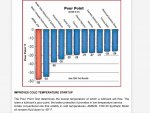SAE seems still confusing to most people...
The "winter" denomination (and yes, W means winter)
is pretty straight forward and easy to remember (for all but americans tbh...)
0°C (freezing water for you fahrenheit users)
Here's how:
20W oil is just liquid enough to be pumped at -20°C (SAE J 300)
and now follow the steps in opposite direction...
15W oil -> -25°C
10W oil -> -30°C
5W oil -> -35°C
0W oil -> -40°C
and of course :
25W -> -15°C
30W -> -10°C etc...
the high temp scale works differently..
it denotes the viscosity of an oil at a fixed (high'ish) temperature namely 100°C (boiling water)
in terms of flow rate
thinnest:
SAE 8 is 1,7 mm²/s
SAE 12 is 2,0 mm²/s
SAE 16 is 5,6 mm²/s
SAE 20 is 6,9 mm²/s
SAE 30 is 9,3 mm²/s
SAE 40 is 12,5 mm²/s
SAE 50 is 16,3 mm²/s
thickest oil
SAE 60 with 21,9 mm²/s
you can take the winter rating as an indicator of ambient temperature.
you cannot do the same with the "summer" rating.. it's pointless...
a combustion engine running is ALWAYS way hotter than the ambient temperature,
so there wouldn't be any point.
but a SAE 30 rating (right part of the number) has always the same min rating (9.3 mm²/s)
no matter what the left side of the number denotes..
it can be better (thicker) but never worse.
so if the manual calls for 10W-30 and you get 5W-30 you will be fine, there will be next to no difference in summer and it only stays liquid enough to start your engine when you left it outside in the winter... in siberia!
'sid
The "winter" denomination (and yes, W means winter)
is pretty straight forward and easy to remember (for all but americans tbh...)
0°C (freezing water for you fahrenheit users)
Here's how:
20W oil is just liquid enough to be pumped at -20°C (SAE J 300)
and now follow the steps in opposite direction...
15W oil -> -25°C
10W oil -> -30°C
5W oil -> -35°C
0W oil -> -40°C
and of course :
25W -> -15°C
30W -> -10°C etc...
the high temp scale works differently..
it denotes the viscosity of an oil at a fixed (high'ish) temperature namely 100°C (boiling water)
in terms of flow rate
thinnest:
SAE 8 is 1,7 mm²/s
SAE 12 is 2,0 mm²/s
SAE 16 is 5,6 mm²/s
SAE 20 is 6,9 mm²/s
SAE 30 is 9,3 mm²/s
SAE 40 is 12,5 mm²/s
SAE 50 is 16,3 mm²/s
thickest oil
SAE 60 with 21,9 mm²/s
you can take the winter rating as an indicator of ambient temperature.
you cannot do the same with the "summer" rating.. it's pointless...
a combustion engine running is ALWAYS way hotter than the ambient temperature,
so there wouldn't be any point.
but a SAE 30 rating (right part of the number) has always the same min rating (9.3 mm²/s)
no matter what the left side of the number denotes..
it can be better (thicker) but never worse.
so if the manual calls for 10W-30 and you get 5W-30 you will be fine, there will be next to no difference in summer and it only stays liquid enough to start your engine when you left it outside in the winter... in siberia!
'sid
Last edited:







